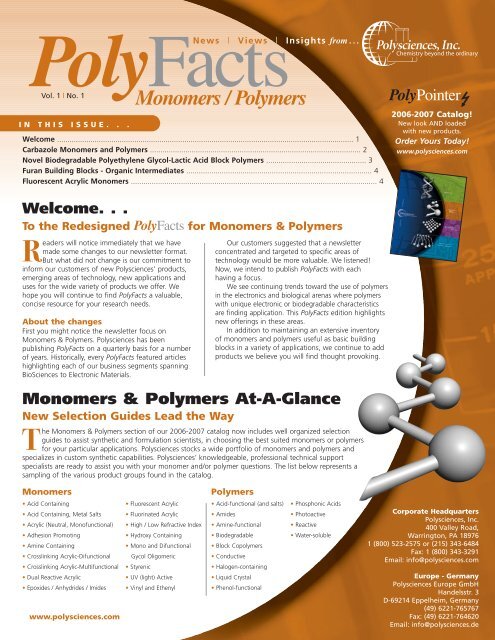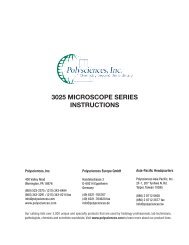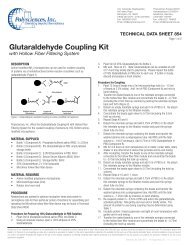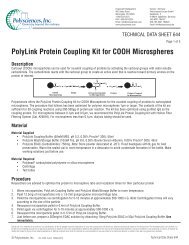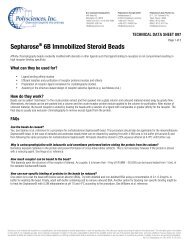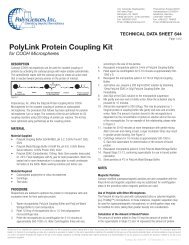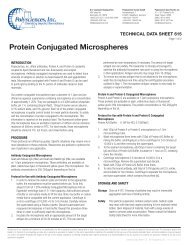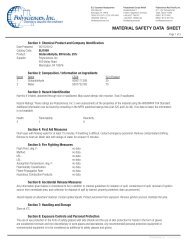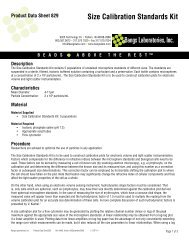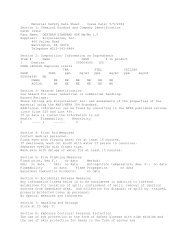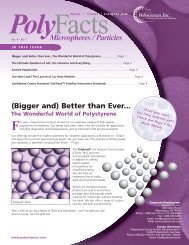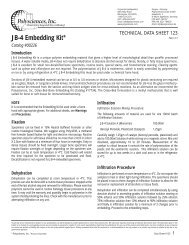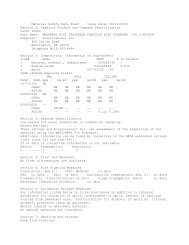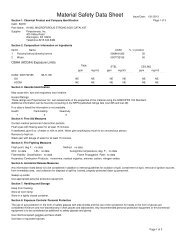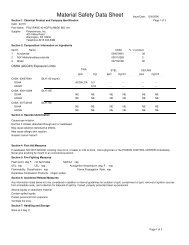PolyFacts - Monomers/Polymers - Polysciences, Inc.
PolyFacts - Monomers/Polymers - Polysciences, Inc.
PolyFacts - Monomers/Polymers - Polysciences, Inc.
You also want an ePaper? Increase the reach of your titles
YUMPU automatically turns print PDFs into web optimized ePapers that Google loves.
<strong>PolyFacts</strong><br />
News l Views l Insights from . . .<br />
Vol. 1 | No. 1<br />
IN THIS ISSUE. . .<br />
<strong>Monomers</strong> / <strong>Polymers</strong><br />
Welcome .............................................................................................................................................. 1<br />
Carbazole <strong>Monomers</strong> and <strong>Polymers</strong> ..................................................................................................... 2<br />
Novel Biodegradable Polyethylene Glycol-Lactic Acid Block <strong>Polymers</strong> ................................................ 3<br />
Furan Building Blocks - Organic Intermediates ......................................................................................... 4<br />
Fluorescent Acrylic <strong>Monomers</strong> ...................................................................................................................... 4<br />
PolyPointer<br />
2006-2007 Catalog!<br />
New look AND loaded<br />
with new products.<br />
Order Yours Today!<br />
www.polysciences.com<br />
Welcome. . .<br />
To the Redesigned <strong>PolyFacts</strong> for <strong>Monomers</strong> & <strong>Polymers</strong><br />
Readers will notice immediately that we have<br />
made some changes to our newsletter format.<br />
But what did not change is our commitment to<br />
inform our customers of new <strong>Polysciences</strong>’ products,<br />
emerging areas of technology, new applications and<br />
uses for the wide variety of products we offer. We<br />
hope you will continue to find <strong>PolyFacts</strong> a valuable,<br />
concise resource for your research needs.<br />
About the changes<br />
First you might notice the newsletter focus on<br />
<strong>Monomers</strong> & <strong>Polymers</strong>. <strong>Polysciences</strong> has been<br />
publishing <strong>PolyFacts</strong> on a quarterly basis for a number<br />
of years. Historically, every <strong>PolyFacts</strong> featured articles<br />
highlighting each of our business segments spanning<br />
BioSciences to Electronic Materials.<br />
Our customers suggested that a newsletter<br />
concentrated and targeted to specific areas of<br />
technology would be more valuable. We listened!<br />
Now, we intend to publish <strong>PolyFacts</strong> with each<br />
having a focus.<br />
We see continuing trends toward the use of polymers<br />
in the electronics and biological arenas where polymers<br />
with unique electronic or biodegradable characteristics<br />
are finding application. This <strong>PolyFacts</strong> edition highlights<br />
new offerings in these areas.<br />
In addition to maintaining an extensive inventory<br />
of monomers and polymers useful as basic building<br />
blocks in a variety of applications, we continue to add<br />
products we believe you will find thought provoking.<br />
<strong>Monomers</strong> & <strong>Polymers</strong> At-A-Glance<br />
New Selection Guides Lead the Way<br />
The <strong>Monomers</strong> & <strong>Polymers</strong> section of our 2006-2007 catalog now includes well organized selection<br />
guides to assist synthetic and formulation scientists, in choosing the best suited monomers or polymers<br />
for your particular applications. <strong>Polysciences</strong> stocks a wide portfolio of monomers and polymers and<br />
specializes in custom synthetic capabilities. <strong>Polysciences</strong>’ knowledgeable, professional technical support<br />
specialists are ready to assist you with your monomer and/or polymer questions. The list below represents a<br />
sampling of the various product groups found in the catalog.<br />
<strong>Monomers</strong><br />
<strong>Polymers</strong><br />
• Acid Containing<br />
• Acid Containing, Metal Salts<br />
• Acrylic (Neutral, Monofunctional)<br />
• Adhesion Promoting<br />
• Amine Containing<br />
• Crosslinking Acrylic-Difunctional<br />
• Crosslinking Acrylic-Multifunctional<br />
• Dual Reactive Acrylic<br />
• Epoxides / Anhydrides / Imides<br />
www.polysciences.com<br />
• Fluorescent Acrylic<br />
• Fluorinated Acrylic<br />
• High / Low Refractive Index<br />
• Hydroxy Containing<br />
• Mono and Difunctional<br />
Gycol Oligomeric<br />
• Styrenic<br />
• UV (light) Active<br />
• Vinyl and Ethenyl<br />
• Acid-functional (and salts)<br />
• Amides<br />
• Amine-functional<br />
• Biodegradable<br />
• Block Copolymers<br />
• Conductive<br />
• Halogen-containing<br />
• Liquid Crystal<br />
• Phenol-functional<br />
• Phosphonic Acids<br />
• Photoactive<br />
• Reactive<br />
• Water-soluble<br />
Corporate Headquarters<br />
<strong>Polysciences</strong>, <strong>Inc</strong>.<br />
400 Valley Road,<br />
Warrington, PA 18976<br />
1 (800) 523-2575 or (215) 343-6484<br />
Fax: 1 (800) 343-3291<br />
Email: info@polysciences.com<br />
Europe - Germany<br />
<strong>Polysciences</strong> Europe GmbH<br />
Handelsstr. 3<br />
D-69214 Eppelheim, Germany<br />
(49) 6221-765767<br />
Fax: (49) 6221-764620<br />
Email: info@polysciences.de
<strong>PolyFacts</strong><br />
<strong>Monomers</strong> / <strong>Polymers</strong><br />
Carbazole <strong>Monomers</strong><br />
and <strong>Polymers</strong><br />
Carbazole is one of a group<br />
of organic heterocyclic<br />
compounds containing a<br />
dibenzopyrrole system, also<br />
known as 9-azafluorene. 1<br />
In general, Carbazoles are a large and<br />
intriguing group of organic compounds<br />
among which one can find dyestuffs,<br />
active pharmaceutical ingredients, and<br />
plastics. 1,2<br />
The basic heterocyclic aromatic<br />
compound containing a dibenzopyrrole<br />
system—Carbazole—is produced during<br />
coal gasification and even in cigarette<br />
smoke. Several thousand tons of carbazole<br />
are produced commercially each year from<br />
crude anthracene fractions of coal tar and<br />
crude oil. Carbazole is used as a raw<br />
material and intermediate in manufacturing<br />
of dyes (e.g., pigment Violet-23 which has<br />
broad utility in different applications from<br />
inks to contact lenses), pharmaceuticals<br />
(e.g., heterocyclic analogues of carbazole<br />
alkaloids such as Ellipticine related<br />
compounds and Indolocarbazoles that have<br />
antitumor, antiviral and protein kinase<br />
inhibitor activities), also for UV-sensitive<br />
and photoconductive polymers.<br />
One of the interesting molecules<br />
derived from carbazole is N-Vinylcarbazole.<br />
(Fig. 1) This reactive monomer is<br />
manufactured from carbazole and<br />
acetylene at high pressures and<br />
temperatures. Utilizing bulk, emulsion,<br />
or suspension polymerization techniques,<br />
N-Vinylcarbazole can be converted into<br />
poly(N-Vinylcarbazole), a unique organic<br />
photoconductive polymer. 3 These polymers<br />
have demonstrated great utility and are of<br />
continuing interest to the electronics<br />
industry. Organic photo-conductors based<br />
on poly(N-Vinylcarbazole) are in use daily<br />
across the globe in laser printers and copy<br />
machines.<br />
<strong>Polysciences</strong> is pleased to add a new<br />
carbazole monomer to our portfolio:<br />
2-(9H-Carbazol-9-yl)ethyl methacrylate<br />
(Fig. 2) which has been investigated for<br />
use in non-linear optical materials.<br />
This novel monomer is a solvent soluble,<br />
crystalline solid which polymerizes readily<br />
Fig. 2<br />
(Cat. #24372)<br />
N<br />
O<br />
O<br />
with a variety of monomers. <strong>Polymers</strong><br />
derived from this monomer often show<br />
improved solubility and tractability versus<br />
poly(N-Vinylcarbazole) analogs.<br />
Carbazole and its numerous derivatives<br />
possess both desirable physical properties<br />
and favorable conductive behavior such<br />
that numerous potential applications, such<br />
as high density optical data storage, optical<br />
image processing, phase conjugated<br />
mirrors, dynamic holography, optical<br />
computing, parallel optical logic, pattern<br />
recognition, biosensors, and biological<br />
transistors are all under current<br />
investigation. PF<br />
References<br />
1) Parker, S.P., Ed. In chief; McGraw-Hill Dictionary of Chemistry;<br />
McGraw-Hill Book Co.; New York, NY, 1997: 67.<br />
2) http://www.polymers.tudelft.nl/wubweb/PDF/MW60-Diduch-etal<br />
Synth%20Metals-139-515-520 2003.pdf<br />
3) Technical Data Sheet #263.<br />
http://www.polysciences.com/shop/assets/datasheets/263.pdf<br />
<strong>Polysciences</strong> stocks both carbazole monomers and polymers for your research<br />
Description Cat. # Size<br />
N-Vinylcarbazole 02429 100g<br />
Poly(N-Vinylcarbazole) 02428 50g<br />
N<br />
2-(9H-Carbazol-9-yl)ethyl methacrylate 24372 1g, 5g<br />
Fig. 1<br />
(Cat. #02429)<br />
Request your FREE copy of the 2006-2007 <strong>Polysciences</strong>, <strong>Inc</strong>. catalog<br />
which contains detailed information on all of our monomers and polymers.<br />
Visit www.polysciences.com today!<br />
2<br />
U.S. & Canada: (800) 523-2575 / (215) 343-6484 Fax: (800) 343-3291 / (215) 343-0214 email: info@polysciences.com
Novel Biodegradable Polyethylene<br />
Glycol-Lactic Acid Block <strong>Polymers</strong><br />
The exploration of polyethylene<br />
glycolated (PEG) materials in<br />
biosciences and pharmaceutics has<br />
grown rapidly. Biomolecule conjugates with<br />
PEG polymer derivatives have shown<br />
increased bioavailability in contrast to the<br />
non-conjugated molecule.<br />
Polymer structures featuring<br />
polyethylene glycol (PEG) segments with<br />
biodegradable or biocompatible segments<br />
offer micellular, nano and microsphere<br />
morphologies which<br />
are useful for<br />
controlled release<br />
formulations. When<br />
coupled with a target<br />
guest molecule,<br />
these micelles offer<br />
both a protective<br />
sheath and an ability<br />
to regulate slow release. Comb/graft<br />
or block polymer architectures are typically<br />
employed to isolate the PEG segments of<br />
the polymer to facilitate the proper<br />
formation of the micelle or microsphere<br />
morphology. <strong>Polysciences</strong> offers a wide<br />
array of glycolated, reactive monomers<br />
which enable the material scientist to<br />
design and synthesize a variety of polymer<br />
architectures having integral PEG segments.<br />
H<br />
O<br />
diblock<br />
O<br />
M<br />
O<br />
For researchers not inclined to design<br />
or synthesize their own polymers,<br />
<strong>Polysciences</strong> has an expanded portfolio<br />
of PEG block copolymers. Research in<br />
drug delivery and tissue engineering has<br />
revealed the interesting properties of<br />
polyethylene glycol–b-lactic acid copolymers.<br />
For example, PEG-b-PLA block copolymers<br />
have been used to develop formulations for<br />
carrying bone morphogenetic protein. 1,2<br />
Cancer researchers have also used PEG/PLA<br />
N<br />
O<br />
block copolymers as micellar anticancer<br />
carriers. 3,4 Researchers have used the block<br />
copolymers for nano/micro-sphere formulation<br />
for drug delivery purposes. 5,6 PEG/PLA<br />
block copolymers have also been used in<br />
formulation of artificial blood systems. 7<br />
We have a rich selection of diblock<br />
and triblock copolymers comprising PEG<br />
and polylactic acid (PLA). The PLA segments<br />
are synthesized from d,l-lactic acid.<br />
Diblock <strong>Polymers</strong> (Numbers in parentheses refer to Mw of the segment)<br />
Description Cat. # Size<br />
PEG(350)-b-PLA(300) 24375 1g<br />
PEG(1000)-b-PLA(750) 24378 1g<br />
PEG(1000)-b-PLA(5000) 24381 1g<br />
PEG(5000)-b-PLA(1000) 24386 1g<br />
PEG(5000)-b-PLA(5000) 24389 1g<br />
H<br />
O<br />
triblock<br />
O<br />
O<br />
O<br />
L M N<br />
<strong>Polymers</strong> of polylactic acid are fully<br />
biodegradable. The PLA segments in<br />
PEG/PLA diblock and triblock polymers will<br />
show similar behavior. This selection of<br />
block polymers is representative of a<br />
synthetic technology with broad structural<br />
control. If desired, other members of the<br />
family could be synthesized.<br />
This class of highly engineered polymers<br />
will open new possibilities to researchers<br />
exploring uses of biodegradable micelles,<br />
microspheres and controlled<br />
release morphologies. All<br />
<strong>Polysciences</strong> PEG/PLA block<br />
polymers are available in 1<br />
gram quantities. PF<br />
OH<br />
O<br />
References<br />
1) Miyamoto, S.; etal, Polylactic acid-polyethylene glycol block copolymer.<br />
A new biodegradable synthetic carrier for bone morphogenetic<br />
protein. Clin Orthop Relat Res. 1993 Sep;(294):333-43.<br />
2) Saito, N., etal, Synthetic biodegradable polymers as drug delivery<br />
systems for bone morphogenetic proteins. Adv Drug Deliv Rev. 2005<br />
May 25;57(7):1037-48. Epub 2005 Apr 15. Review.<br />
3) Liggins RT, Burt HM., Polyether-polyester diblock copolymers for the<br />
preparation of paclitaxel loaded polymeric micelle formations.<br />
Adv Drug Delivery Rev. 2002; 54:191-202.<br />
4) Liu, L., etal, Biodegradable Polylactide/Poly(ethylene glycol)/Polylactide<br />
Triblock Copolymer Micelles as Anticancer Drug Carriers. Journal of<br />
Applied Polymer Science, Vol. 80, 1976–1982 (2001)<br />
5) Kwon, G. D. Diblock copolymer nanoparticles for drug delivery.<br />
Crit Rev Ther Drug Carrier Syst. 1998; 15(5):481-512. Review.<br />
6) Jeong B, etal., Biodegradable block copolymers as injectable<br />
drug-delivery systems. Nature, 1997; 388, 860-862.<br />
7) Chang TM, etal., Analysis of polyethylene-glycol-polylactide<br />
nanodimension artificial red blood cells in maintaining systemic<br />
hemoglobin levels and prevention of methemoglobin formation.<br />
Artif Cells Blood Substit Immobil Biotechnol., 2003; Aug; 31, (3):231-47.<br />
Special<br />
Limited Time<br />
Offer<br />
Triblock <strong>Polymers</strong> (Numbers in parentheses refer to Mw of the segment)<br />
Description Cat. # Size<br />
PLA(1000)-b-PEG(1000)-b-PLA(1000) 24500 1g<br />
PLA(2000)-b-PEG(1000)-b-PLA(2000) 24501 1g<br />
PLA(5000)-b-PEG(1000)-b-PLA(5000) 24502 1g<br />
PLA(1000)-b-PEG(4000)-b-PLA(1000) 24503 1g<br />
PLA(1000)-b-PEG(10,000)-b-PLA(1000) 24509 1g<br />
Visit www.polysciences.com<br />
for more details.<br />
To take advantage of this offer, place promotional code 0606PEGPLAW in the<br />
"comments" field during final purchase approval when ordering via the web.<br />
Europe: +(49) 6221-765767 Fax: +(49) 6221-764620 email: info@polysciences.de www.polysciences.com<br />
3
<strong>PolyFacts</strong><br />
<strong>Monomers</strong> / <strong>Polymers</strong><br />
Furan Building Blocks<br />
New Furan Based Synthons Finding Uses in Organic & Polymer Applications<br />
Furan based synthons are finding new uses in organic and<br />
polymer synthesis applications including pharmaceutical,<br />
graphic arts, agricultural, flavor/fragrance as well as organic<br />
intermediates industries.<br />
<strong>Polysciences</strong> <strong>Inc</strong>. is pleased to announce the availability of<br />
a family of furan derivatives including the difficult-to-find 3rd<br />
2 Position Substituted Furans<br />
• 2-furaldehyde (furfural)<br />
• 2-furfuryl alcohol<br />
• 2-ethoxymethyl furan<br />
• 2-acetyl furan<br />
• 2-bromofuran<br />
• 2-butanoylfuran<br />
• 2-butyl furan<br />
• 2-ethylfurfuryl ether<br />
• 2-furfuryl acetate<br />
• 2-furfuryl amine<br />
• 2-furoic acid<br />
• 2-heptyl furan<br />
• 2-methyl furan<br />
• 2-methyl furoate<br />
• 2-methyl tetrahydrofuran<br />
• 2-methyl tetrahydrofuroate<br />
• 2-pentyl furan<br />
2-furaldehyde (furfural)<br />
• 2-tetrahydrofurfuryl acetate<br />
• 2-tetrahydrofurfuryl amine<br />
• 2-tetrahydrofurfuryl butyrate<br />
• 2-tetrahydrofurfuryl propionate<br />
• difuryl propane<br />
• ditetrahydrofuryl propane<br />
• ethyl 2-furoate<br />
• tetrahydrofurfuryl alcohol<br />
• tetrahydrofurfuryl benzoate<br />
• tetrahydrofuroic acid<br />
position substituted furanes. Unique boronic acid or halogen<br />
functional furan building blocks are appropriate for use in “Suzuki<br />
Synthesis” 1,2 carbon-carbon bond forming reactions catalyzed by<br />
palladium. Please visit: www.polysciences.com to learn more<br />
about these exciting new materials.<br />
3 Position Substituted Furans<br />
• 3-bromofuran<br />
• 3-furaldehyde<br />
• 3-furan boronic acid<br />
2,5 Disubstituted Furans<br />
• 2,5 dibromofuran<br />
• 2,5 diethyl tetrahydrofuran<br />
• 2,5 dimethyl furan<br />
• 2-methyl-5-acetyl furan<br />
• 2-methyl-5-butanoylfuran<br />
• 2-methyl-5-pentanoyl furan<br />
• bis-(hydroxymethyl) furan<br />
• methyl 2-bromofuran carboxylate<br />
3,4 Disubstituted Furans<br />
• dimethyl 3,4 furan dicarboxylate<br />
• furan-3,4 dicarboxylic acid<br />
For specialized derivatives of these or other furans, call for a quotation!<br />
O<br />
3-bromofuran<br />
References<br />
1) N. Miyaura and A. Suzuki, Chem. Rev., 95, 2457, 1995<br />
2) A. Suzuki, Metal-catalyzed Cross Coupling Reactions, Wiley-VCH, 49-97 (1988)<br />
3) Y. Matsuya et. al. “Synthesis of a new class of furan fused tetracyclic compounds using o-quino dimethane chemistry and investigation of their anti-viral activity”, J. Org. Chem., 69(23) 7989-93 2004<br />
4) J.A. Castro Hermida et.al.,”Anti Cryptosporidial activity of furan derivative G-1 and its inclusion complex with B-cyclodextrin,” J. Pharm. Sci., 93(1) 197-206 2004<br />
Fluorescent Acrylic <strong>Monomers</strong><br />
<strong>Monomers</strong> with fluorescent tags are often used to build<br />
polymers that can be detected at very low concentrations<br />
using fluorescence spectroscopy. Polymer migration and<br />
diffusion has been studied using fluorescent tags.<br />
Polymer microspheres containing fluorescent groups are used<br />
routinely for flow cytometry and medical diagnostic assays. Some<br />
examples of our range of Fluorescent Acrylic <strong>Monomers</strong> are shown<br />
at right. To learn more about our Fluorescent <strong>Monomers</strong>, please go<br />
to: http://www.polysciences.com/shop/assets/datasheets/513.pdf<br />
to download Technical Data Sheet #513.<br />
H3C<br />
O<br />
Br<br />
O CH 3<br />
2-methyl-5-acetyl furan<br />
HO<br />
O<br />
O<br />
O<br />
OH<br />
furan-3,4 dicarboxylic acid<br />
Description Cat. # Size(s)<br />
3,8-Dimethylacryloyl ethidium bromide 23590 100mg, 1g<br />
Methacryloxyethyl thiocarbamoyl rhodamine 23591 100mg, 1g<br />
9-Anthracenylmethyl methacrylate 23587 100mg, 1g<br />
Fluorescein dimethacrylate 23589 100mg, 1g<br />
O-Methacryloyl Hoechst 33258 23592 100mg, 1g<br />
2-Naphthyl acrylate 06024 1g<br />
2-Naphthyl methacrylate 23602 100mg, 1g<br />
1-Pyrenylmethyl methacrylate 23588 100mg, 1g<br />
Turning Bright Ideas Into Reality for Over 40 Years! Custom Synthesis & Contract Manufacturing<br />
◆ FDA Registered Facility ◆ GMP Compliant Batch Records<br />
◆ Unique <strong>Monomers</strong> & <strong>Polymers</strong> ◆ Ultra-pure Specialty & Fine Chemicals<br />
◆ Custom Synthesis to Your Specifications<br />
◆ Start-Ups, Pilot Scale-Up, or Full-Scale Production<br />
Call Us Today to See What Idea We Can Make Into a Reality for You!<br />
U.S. & Canada: 1 (800) 523-2575, Europe:(49) 6221-765767<br />
70082<br />
<strong>Polysciences</strong>, <strong>Inc</strong>. 400 Valley Road, Warrington, PA 18976 Phone: 1 (800) 523-2575 / (215) 343-6484 Fax: (800) 343-3291 / (215) 343-0214 email: info@polysciences.com<br />
<strong>Polysciences</strong> Europe GmbH Handelsstr. 3 D-69214 Eppelheim, Germany Phone: (49) 6221-765767 Fax: (49) 6221-764620 email: info@polysciences.de
www.polysciences.com<br />
SAR-GEL ®<br />
SAR-GEL ® , Water Indicating Paste<br />
Catalog #24615<br />
Water indicating paste provides a fast, reliable way<br />
to detect water bottoms in storage tanks containing<br />
gasoline and gasoline/alcohol blends, diesel, jet fuel,<br />
fuel oil, solvents and other materials.<br />
Advantages:<br />
• Easy to apply - no messy jars, no need to mix<br />
• No guessing - complete color change from white<br />
to brilliant pink<br />
• Faster reaction - immediate detection means less<br />
time wasted<br />
• Easy to see water line - does not run<br />
• Fast, easy cleanup<br />
SAR-GEL ® is easy to use:<br />
1 2 3 4<br />
Apply a small amount of<br />
SAR-GEL ® paste to the<br />
end of dip stick.<br />
Spread over surface.<br />
Insert dip stick in tank for<br />
10 seconds.<br />
Presence of water<br />
indicated where SAR-GEL ®<br />
paste turns brilliant pink.<br />
Stock up on SAR-GEL ® with our<br />
Buy 5 Tubes, Get 1 FREE<br />
2006 Promotion<br />
Catalog #24615-1 SAR-GEL ® 1oz tube<br />
Offer Expires December 31, 2006<br />
Please use promo code: SARGEL2006 to receive Buy 5 tubes, Get 1 free offer. Visit www.polysciences.com and enter SARGEL2006 in the Comments field during Final Purchase Approval<br />
when ordering via the web. Web orders will not show free tube at time of purchase. One free tube will be applied to the order and appear on the invoice. Offer for buy 5 SAR-GEL<br />
tubes, get 1 FREE valid until December 31, 2006 on orders placed by phone, fax or web. Offer can not be combined with any other discount or promotion on same products.<br />
Headquarters | 400 Valley Road, Warrington, PA 18976 | Phone: (800) 523-2575 / (215) 343-6484 | Fax: (800) 343-3291 / (215) 343-0214 | email: info@polysciences.com<br />
<strong>Polysciences</strong> Europe GmbH | Handelsstr. 3 D-69214 Eppelheim, Germany | Phone: (49) 6221-765767 | Fax: (49) 6221-764620 | email: info@polysciences.de<br />
70073


